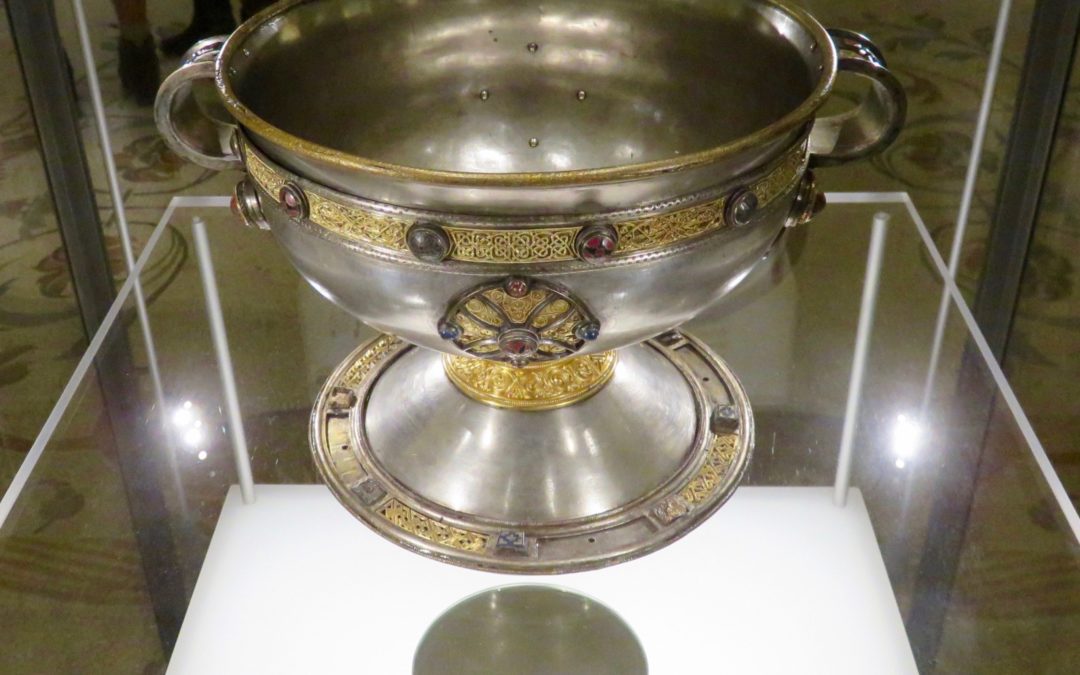Two Irish lads, Jim Quinn and Paddy Flanagan, were digging around in a potato field in 1878 when they struck silver. They dug up a hoard of stunning metalwork dating back to the 7th or 8th centuries—a treasure trove that included the famous Chalice of Ardagh.
My wife and I were in Ireland last September, and we saw the Chalice of Ardagh in the National Museum of Ireland in Dublin. But the chalice is more than just a gorgeous piece of craftsmanship; it also carries a powerful Christian message.
In his book, How the Irish Saved Civilization, Thomas Cahill makes a fascinating comparison between this chalice and a second cup—the Gudenstrup Cauldron, which can also be found on display in the National Museum of Ireland (although it was out on loan when we visited). The Gundestrup Cauldron was discovered in a swamp, where a Celtic had dumped it long before the birth of Christ.
The contrast between the pagan cauldron and the Chalice of Ardagh couldn’t be more dramatic. According to Cahill, the chalice and the cauldron show how the Irish imagination moved from “unstable pagan origins†to the “baptized peace†of the Christian message.
Depicted on the side of the cauldron, Cahill says, was “a gigantic cook-god who drops squirming humans into a vat†as if people are lobsters being dropped in boiling water. The cauldron swarms with the images of monsters and angry gods who demand both animal and human sacrifice.
The difference between the cauldron and the Chalice of Ardagh is like night and day. The chalice is a communion cup, and it contains a completely different message. In communion, God does not demand the blood of human sacrifice. Instead of human blood being spilled to appease the gods, the Christian message is the reverse. God spilled His blood for us, and we remember this every time we take communion.
When I saw the Chalice of Ardagh, I noticed that the museum had placed a mirror below it, so people can see the artwork etched on the underside of the chalice’s base. But you might be asking yourself: Why put artwork on the bottom of the base? Who in the world is going to see it?
The answer: God sees the art on the underside of the chalice. When you drink of the cup and raise the chalice, the base points to the sky and only God can see the artwork on the bottom. It’s just another way that the chalice creates a special connection between humanity and God. In the pagan world, people were separated from the gods by a deep abyss, but through communion, Jesus creates a bridge across the abyss, uniting God and humanity.
In his missionary work, St. Patrick played a major role in making possible the switch from the pagan to the Christian world in Ireland. He led the dramatic transformation from a culture where gods devour humans to a culture where God gives His life for His people.
So let me end with a poem that Patrick is often given credit for composing—a poem that reflects God’s light and love in a magnificent way. I don’t have space to include the entire poem, but here is an excerpt:
I arise today
Through the strength of heaven:
Light of sun,
Radiance of moon,
Splendor of fire,
Speed of lightning,
Swiftness of wind,
Depth of sea,
Stability of earth,
Firmness of rock.
I arise today
Through God’s strength to pilot me:
God’s might to uphold me,
God’s eye to look before me,
God’s ear to hear me,
God’s word to speak for me,
God’s hand to guard me,
God’s way to lie before me,
God’s shield to protect me,
God’s host to save me
From snares of devils,
From temptations of vices,
From everyone who shall wish me ill,
Afar and near,
Alone and in multitude.
It’s little wonder that this poem is called “Saint Patrick’s Breastplate.†If you surround yourself with a prayer like that, who needs actual armor? These words are as strong as any iron.
By Doug Peterson

